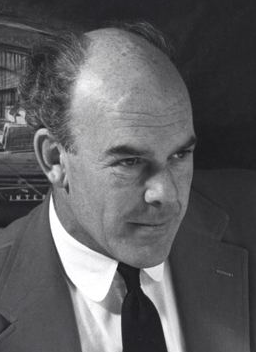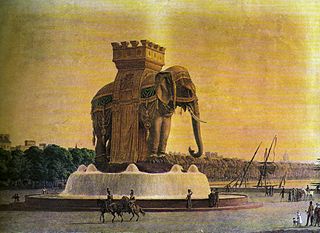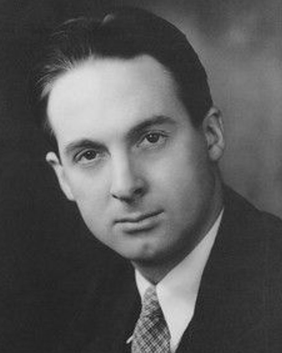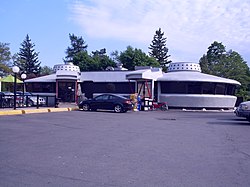
Googie architecture is a type of futurist architecture influenced by car culture, jets, the Atomic Age and the Space Age. It originated in Southern California from the Streamline Moderne architecture of the 1930s, and was popular in the United States from roughly 1945 to the early 1970s.

John Edward Lautner was an American architect. Following an apprenticeship in the mid-1930s with the Taliesin Fellowship led by Frank Lloyd Wright, Lautner opened his own practice in 1938, where he worked for the remainder of his career. Lautner practiced primarily in California, and the majority of his works were residential. Lautner is perhaps best remembered for his contribution to the development of the Googie style, as well as for several Atomic Age houses he designed in the late 1950s and early 1960s, which include the Leonard Malin House, Paul Sheats House, and Russ Garcia House.

Mel's Drive-In is a term referring to two American restaurant chains, the successors of a chain founded in 1947 by Mel Weiss and Harold Dobbs in San Francisco, California. It is closely associated with the film American Graffiti.

Novelty architecture, also called programmatic architecture or mimetic architecture, is a type of architecture in which buildings and other structures are given unusual shapes for purposes such as advertising or to copy other famous buildings. Their size and novelty means that they often serve as landmarks. They are distinct from architectural follies, in that novelty architecture is essentially usable buildings in eccentric form whereas follies are non-usable, purely ornamental buildings also often in eccentric form.

Wayne Douglas McAllister was a Los Angeles-based architect who was a leader in the Googie style of architecture that embraced the automobile and the Space Age. Inspired by tail fins and gleaming chrome, he elevated the drive-in restaurant and the theme hotel to futuristic works of art. His 1941 El Rancho Vegas was the very first resort hotel on the Las Vegas Strip, and his iconic 1949 Bob's Big Boy restaurant in Burbank, California is a California historical landmark. He created iconic circular drive-in restaurants in Southern California, including Simon's, Herbert's, and Robert's in the 1930s.
Alan Hess is an American architect, author, lecturer and advocate for twentieth-century architectural preservation.

Pann's is a coffee shop restaurant in the Westchester neighborhood of Los Angeles, California, known for its history, role in movies, and distinctive architecture. The restaurant was opened by husband and wife George and Rena Poulos in 1958. It is also known for its neon sign, Googie architecture, and 1950s decor. The building and its iconic neon sign were designed by architects Eldon Davis and Helen Liu Fong of the Armet & Davis architectural firm. Pann's remains one of the best preserved examples of Davis' Googie designs, according to the Los Angeles Times.
Armet Davis Newlove Architects, formerly Armét & Davis, is a Californian architectural firm known for working in the Googie architecture style that marks many distinctive coffee shops and eateries in Southern California. The firm designed Pann's, the first Norms Restaurants location, the Holiday Bowl and many other iconic locations.

Wich Stand was a '50s-style coffee shop restaurant and diner in Los Angeles, California, featuring a tilting blue roof and 35-foot spire (11 m), designed by architect Eldon Davis.

Johnie's Coffee Shop is a former coffee shop and a well-known example of Googie architecture located on the corner of Wilshire Boulevard and Fairfax Avenue in Los Angeles, California. Architects Louis Armét and Eldon Davis of Armét & Davis designed the building, contributing to their reputation as the premier designers of Space Age or Googie coffee shops—including the landmark Pann's coffee shop in Ladera Heights, Norms Restaurant on La Cienega Boulevard, and several Bob's Big Boy restaurants.
Louis Logue Armét was an American architect and strong proponent of Googie architecture during the mid-twentieth century.

The Lake McDonald Lodge Coffee Shop is a visitor services building in the Lake McDonald district of Glacier National Park, Montana. The coffee shop was built in 1965 as part of the National Park Service's Mission 66 program to upgrade visitor facilities, in order to increase visitor dining capacity. Under the Mission 66 projects, visitor facilities were usually comprehensive in nature, providing a range of visitor services. Specialized concession buildings like the Coffee Shop were unusual in Mission 66. It was leased to the Glacier Park Company for operation, in anticipation of the construction of lodging facilities by the company.

In design, the Atomic Age is the period roughly corresponding from 1940 to 1963, when concerns about nuclear war dominated Western society during the Cold War. Architecture, industrial design, commercial design, interior design, and fine arts were all influenced by the themes of atomic science, as well as the Space Age, which coincided with that period. Atomic Age design became popular and instantly recognizable, with a use of atomic motifs and space age symbols.

Jack Laxer (1927–2018) was an American photographer, known for his work in stereoscopy.

Helen Liu Fong was an American architect and interior designer from Los Angeles, California. Fong was an important figure in the Googie architecture movement, designing futuristic buildings like Norms Restaurant, the Holiday Bowl, Denny's, Bob's Big Boy, and Pann's Coffee Shop that helped usher in an era of boomerang angles, dynamic forms and neon lights. Fong became one of the first women to join the American Institute of Architects, and worked with Armet and Davis on many of her most well-known projects. Many of Fong's best-known building designs feature large glass fronts and bold colors on interior walls, designed to stand out and entice potential customers.
Googie's Coffee Shop was a small restaurant located at 8100 Sunset Boulevard in Los Angeles next door to the famous Schwab's Pharmacy at the beginning of the Sunset Strip. It was designed in 1949 by architect John Lautner and lent its name to Googie architecture, a genre of modernist design in the 1950s and 60s. Interest in the style was revived by the 1986 book Googie: Fifties Coffee Shop Architecture by Alan Hess.
Tiny Naylor's was a restaurant chain in Southern California started in 1949 by William Wallace "Tiny" Naylor and later run by his son Biff Naylor. W.W. Naylor had previously owned more than a dozen Tiny's Waffle Shops in Central California. Naylor moved to Los Angeles and hired architect Douglas Honnold to design an eye-catching drive-in restaurant at the corner of Sunset Boulevard and La Brea Avenue in Hollywood. Actor Humphrey Bogart compared the slanted canopy roof of the building to "a huge bird about to take off.". The restaurant featured Googie architecture and carhop service, and claimed to be the birthplace of the Patty melt. Naylor died on August 17, 1959, while at the Del Mar racetrack. The original location closed on March 11, 1984 and was demolished. The site is currently a shopping center.
W.W. "Biff" Naylor is a retired restaurant owner in Los Angeles, California. He was born in Oakland, California in 1939 and graduated from Pennsylvania State University. His father W.W. “Tiny” Naylor started Tiny's Waffle Shops in Central California in the 1920s, and operated a chain of more than 40 Tiny Naylor's and Biff's restaurants in Southern California. Biff Naylor took over operations of Tiny Naylor's after his father's death in 1959 and was still operating at least one location in 1999. The Biff's restaurant chain of the 1940s was a "forerunner to all the modern coffee shops," Naylor told the San Jose Mercury News in 2016. Those restaurants employed modern architecture in the googie style, and innovations that would be adopted widely through the restaurant industry including open exhibition cooking kitchen, stainless steel counters, refrigerated pie cases, and plate "lowerators" that warmed or cooled plates as needed. In 2017 Los Angeles magazine food critic Patric Kuh called the longtime restaurant operator "Diner royalty". Saveur magazine wrote that Biff Naylor created "The best damn coffee shops ever" in their "Saveur 100" list
Ben Frank's was a restaurant in West Hollywood, California, opened in 1962 by Arthur Simms and Bob Ehrman. The location, surrounded by the famous nightclubs of the Sunset Strip, led to a celebrity clientele, and the 24-hour restaurant became a popular late night destination. The distinctive googie architecture and eye-catching neon sign helped attract musicians like Jim Morrison and Frank Zappa, as well as patrons of the nearby music venues. The youthful patrons that frequented the restaurant inspired the producers of the Monkees TV show to place an ad seeking "spirited Ben Frank's types" when casting the show in 1965.

















